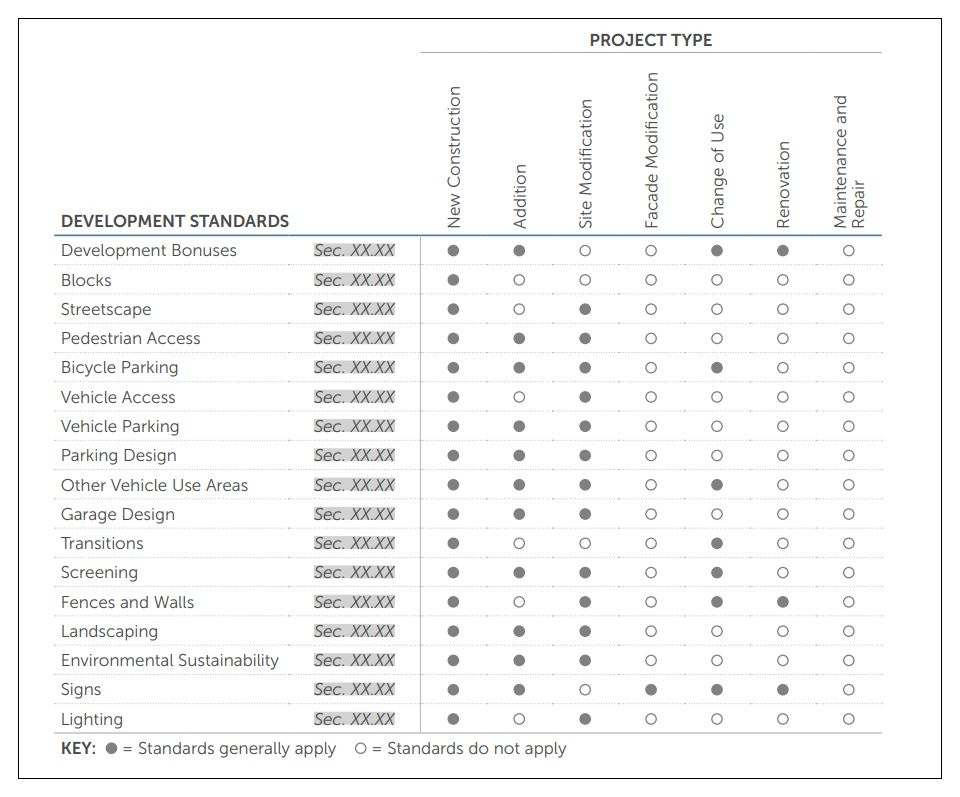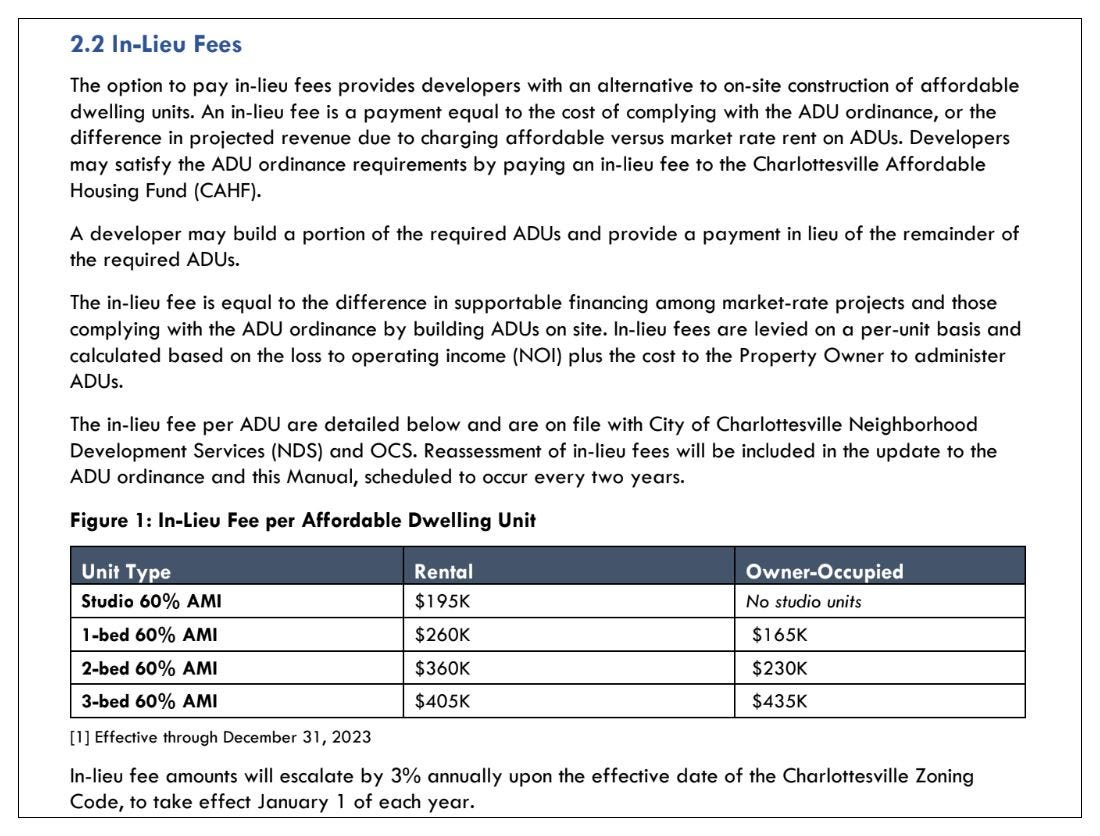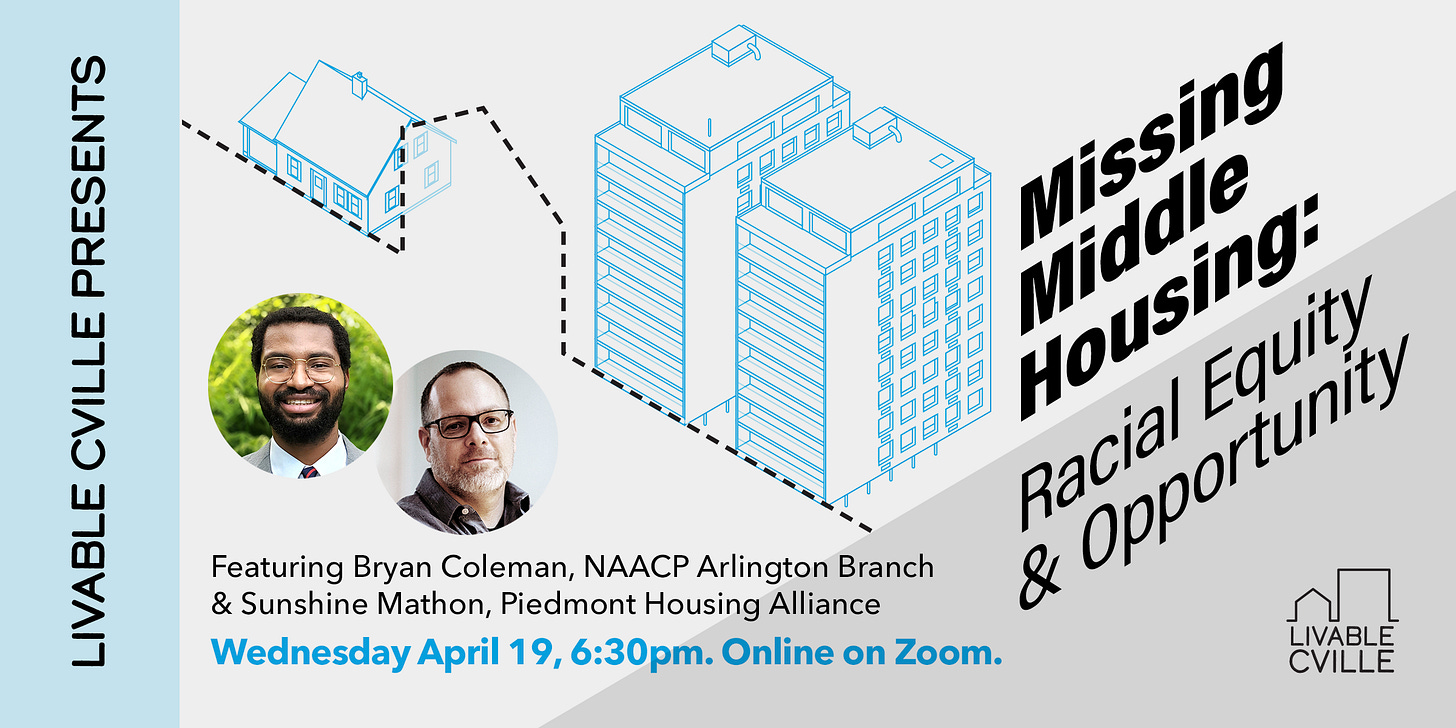I did not anticipate when I played Dungeons and Dragons and other role playing games when I was a young child that a love of obscure manuals would somehow translate into the work I do now. I help interpret the rules of development to people who aren’t familiar with them. This is especially important at a time when those rules are being changed. That’s a key feature of every single edition of Charlottesville Community Engagement, but especially today.
On today’s program:
There’s only one topic and that’s a review of the second module of the Charlottesville’s draft zoning code
There will be no parking requirements in Charlottesville under the draft new zoning code, though larger developments will require a transportation demand management plan
Commissioners and Councilors pushed back on an option to still allow developers to pay into a fund rather than build affordable units
Public comment for this module as well as the first will be taken through April 30
First shout-out: Missing Middle Housing: Racial Equity and Opportunity
In today’s first Patreon-fueled shout-out: Livable Cville has another event coming up that they want you to know about and consider attending. On April 19 at 6:30 p.m. Bryan Coleman, 2nd Vice President of the NAACP Arlington Branch, will provide examples from Arlington on Missing Middle Housing: Racial Equity and Opportunity. As Charlottesville continues a zoning rewrite intended to increase residential density, Coleman will discuss the relationship between Arlington’s current housing debates and racial equity and opportunity. Stay for the question and answer period to hear a local perspective from Sunshine Mathon, Executive Director of the Piedmont Housing Alliance. That’s another Livable Cville webinar coming up on April 19.
Details of second module of Charlottesville’s new zoning code unveiled at work session
At long last, I’m finally able to turn my attention to the release of the second module of the city’s new zoning code. This is the third leg of the Cville Plans Together initiative, a wide-ranging effort to make it easier to build housing in Charlottesville.
The first leg was the adoption of an Affordable Housing Plan in March 2021 that among other things morally commits City Council to spend at least $10 million a year toward building more subsidized housing. (download the plan)
The second was the adoption of a Comprehensive Plan that placed increased residential density across the entire city as a top priority. That included a Future Land Use Map that signaled that all properties could have at least three residential units on them. (download the plan)
This year the details are being finalized on changes to the zoning code to describe how that additional density would be implemented. A first module was released in early February and the second was released on March 29, a little later than originally expected. (read my story on the first module)
March 29 was also the same day the Planning Commission and the City Council were scheduled to go over the work to date. Instead, they got a briefing of what’s in the second module.
Draft Affordable Dwelling Unit (ADU) Monitoring and Procedures Manual
YouTube video of an explanation of what’s in the second module
First, they learned there would be no changes to the zoning map as part of Module 2.
“We’re collecting every single map change that we get, specific or general,” said James Freas, the city’s director of Neighborhood Development Services. “We’re sorting through all of those and we’re going to do an analysis of every single one over the next three weeks or so.”
A new map will be released for review sometime after the module phase is complete and there is a total draft to review. The second module covers development standards.
“Things like landscaping, parking, signage, and lighting,” Freas said. “It’s a big section and there are a lot of things to go over.”
Freas said much of this section refers to existing documents that staff uses to interpret specific applications such as the Streets that Work manual and the Standards and Design Manual. A new document called the Draft Affordable Dwelling Unit (ADU) Monitoring and Procedures Manual.
“Beyond what’s required within the ordinance, that tells us a property owner how they go about submitting their affordability requirements, the details in terms of meeting that requirement, and how that requirement is monitored for enforcement purposes over time,” Freas said.

Each standard begins with an intent section and the first standard listed controls the bonus units allowed if an existing structure is kept. The intent here is: “To provide an incentive for the preservation and rehabilitation of existing housing stock while implementing the affordable housing goals of the adopted Comprehensive Plan and Charlottesville Affordable Housing Plan.”
“I want to state right at the beginning that we are defining affordable housing as housing affordable to somebody earning, a household earning, 60 percent of area median income,” Freas said. “While that’s the standard for purposes of this work, there will be individual programs or policies adopted by the city that will target lower area median incomes.”
The term of affordability is 99 years.
The preservation bonus of one additional unit would come into play if the first 25 feet of an existing structure is kept. This would apply in Residential-A, Residential-B, and Residential-C sections .
In developments larger than ten units, the new zoning would require ten percent of units be affordable. However, the new zoning would preserve the ability of a developer to pay into the Charlottesville Affordable Housing Fund though the required payment has been increased. It’s also worth noting that the Charlottesville Redevelopment and Housing Authority would be exempt from the ten percent requirement.
One Planning Commissioner expressed concern about allowing this payment in lieu option to continue.
“I feel like we’re going to get a lot of pushback on the idea of still being able to pay for affordable units instead of actually building them,” said Planning Commissioner Carl Schwarz.
Freas said that the best practice for inclusionary zoning is to offer the choice of paying into a fund. City Councilor Michael Payne expressed his concern.
“Seeing that, I’m uncomfortable and would like a lot more information and discussion before feeling comfortable and moving back to a payment in lieu option,” Payne said.
Freas said he understood, but reminded the group that the overall zoning push is to make it easier to build affordable housing across the entire city.
“Affordable housing has often been kind of segregated to certain areas,” Freas said. “That’s a product of funding decision but it’s also a product of zoning that our zoning ordinance is attempting to address. Because when affordable housing is primarily multifamily and multifamily is only allowed in certain areas, you right there have created that situation.”
Payne said the existing system has been a failure in terms of producing units. Last year, Council reviewed a report for how $46.7 million was spent through the Charlottesville Affordable Housing Fund since 2010. Nearly half of that money went to construction of units, according to a story I wrote last March.

Developers would also get an additional two stories of height if ten percent of the units are at 50 percent of the area median income.
“The final bonus that we’re proposing is that in the Residential-A, Residential-B, and Residential-C districts, a project could double the allowed density if 100 percent of the project is affordable,” Freas said. “That is the entire project, all units on the site are affordable at 60 percent of AMI or less.”
Freas said the city only expects non-profit groups to take advantage of this provision.
“We don’t anticipate for-profit [and] private sector developers taking advantage of that,” Freas said. “That is really something that the only ones who could take advantage of that is an affordable housing developer who is seeking a subsidy from source from within the existing range of sources that are out there. It’s not on its face financially feasible.”
However, Virginia law would not prevent others from trying as all rules have to apply to all potential owners.
Time for a very short break.
Second shout-out goes to Camp Albemarle
Today’s second subscriber-supported public service announcement goes out to Camp Albemarle, which has for sixty years been a “wholesome rural, rustic and restful site for youth activities, church groups, civic events and occasional private programs.”
Located on 14 acres on the banks of the Moorman’s River near Free Union, Camp Albemarle continues as a legacy of being a Civilian Conservation Corps project that sought to promote the importance of rural activities. Camp Albemarle seeks support for a plan to winterize the Hamner Lodge, a structure built in 1941 by the CCC and used by every 4th and 5th grade student in Charlottesville and Albemarle for the study of ecology for over 20 years. If this campaign is successful, Camp Albemarle could operate year-round. Consider your support by visiting campalbemarleva.org/donate.
More details on the development standards in Charlottesville’s draft zoning code
The new zoning will also create standards for the creation of smaller block sizes to increase connectivity.
“So this requirement basically says where you exceed a certain size of your lot, you are required to introduce a block pattern, new streets, new connecting streets, and so on,” Freas said.
Then there are streetscape requirements. There are: “To help ensure an attractive and inviting public realm that provides a safe and protected walkway for pedestrians.”
“This requirement introduces a size standard for the amount of space in front of the building that needs to be available for sidewalks and a green verge if you will where the street trees and the lighting would be located,” Freas said.
There are also guidelines to make sure pedestrian access to buildings is provided and that spaces for bicycle parking are also provided. Under the new zoning, a developer would not have to provide any space for a motorized vehicle to be stored.
“At this point we are proposing no minimum parking requirement in order to support reuse and redevelopment of sites within the city,” Freas said. “We fully anticipate there will be a great deal of conversation on this topic.”
The draft rules also allow for one driveway per zoning lot, though a permit would be required for a curb cut. There are no requirements for off-street parking though any project over 50,000 square feet must submit a transportation demand management plan. This TDM plan must demonstrate how the landowner will encourage residents or customers to not use a motorized vehicle.
For a good example of a Transportation Demand Management Plan, check out the University of Virginia’s Parking and Transportation Master Plan.
Freas said that one change point may be lowering or raising that 50,000 square foot threshold.
The intent of this section is also worth noting:
“To reduce parking demand, support the use of alternative forms of transportation, promote reuse and redevelopment of existing buildings, reduce the overall cost of construction and development, and increase the overall efficiency and use of taxable land within the City.”
Planning Commissioner Hosea Mitchell cautioned about making it more difficult for visitors to the community to park here.
“Our friends in the surrounding counties are developing economic zones and they’re doing that so that their people don’t have to drive into Charlottesville,” Mitchell said. “If we make it difficult for them to park when they get into Charlottesville, we’re going to start losing business on the Downtown Mall and in Barracks Road
There are also requirements for transitions between higher and lower-intensity areas, as well as details on walls, fences, and required screening of unsightly things like waste disposal and mechanical equipment.
Much of the existing tree preservation ordinance will be kept, but Freas said it will be augmented.
“One of the things that we’re including is the requirement for a tree removal permit,” Freas said. “It makes it very clear that if you are removing a tree over 15 inches in caliper, you are required to get a permit from the city. That allows us and gives us a stronger ability to actually enforce these provisions.”
These permits will be handled by staff with no option for elected officials to intervene. Details on how these permits and others will be dealt with in module 3.

Requests to disturb critical slopes will now be a special exemption rather than a waiver. Other than that, the rules are more or less the same. These will still require review by the Planning Commission and City Council including a public hearing.
Module 2 also includes the first sense of what will be done to help prevent displacement of people are considered to be “Sensitive Communities.” Here’s some language from the Comprehensive Plan:
“Sensitive Community Areas are places throughout Charlottesville that include concentrations of community members who may be demographically sensitive to displacement pressures and potentially most at risk for displacement. Sensitive Community Areas are the General Residential areas that fall within Census Block Groups that have relatively high proportions of the communities listed below, using ACS 2018 5-year estimates.”
Councilor Michael Payne and the rest of the group only had 30 minutes to review the material before the March 29 work session. But, Payne expressed another concern.
“I’m very concerned about these lots that are high percentage of lower income renters who are not subsidized and if you upzone with no protection and you have a lot of capital investment come in, they can very easily be screwed over,” Payne said. “I don’t see anything defined yet on how to conceptualize or deal with that problem.”
Freas said more work needs to be done in conjunction with people who might be affected, or may already be feeling the pressure.
“Because it’s a challenging issue,” Freas said. “Let’s talk about that flood of capital you are referring to. That flood of capital is coming into many of our sensitive community areas right now under our existing single-family homes that are being flipped either in a tear-down scenario or a significant expansion scenario. We’re seeing that happen without changing the zoning ordinance.”
This is an area I’ve tried to document through my ongoing review of Charlottesville property transactions. There’s a lot of money to be made in house-flipping. Go back to the November 2022 transaction report for some questions I asked there and will keep in mind as the work on the zoning code continues.
Freas said another consideration is that wealth-building opportunities will be reduced if those in sensitive communities don’t have the same potential for future growth.
“We’re having that conversation with residents from those communities to say where do you lean in this,” Freas said. “And right now the conversation is mostly, not entirely, but mostly saying that we lean towards more restriction.”
The comment period for both module 1 and module 2 runs through April 30. Commissioner will further discuss the module at their meeting scheduled for today. Visit the Cville Plans Together website to learn more about how you can comment. There’s also an open house tomorrow night and on Saturday.
The Planning Commission went into further detail on Module 1. I’ll have that in a future installment of the program that gets back to a little more of the regular.
Reading material:
The Dewberry stands empty, and it’s silence from the developers, Isabel Cleary, NBC29, April 10, 2023
Charlottesville city budget grows again as approval nears, Hawes Spencer, Charlottesville Daily Progress, April 10, 2023
Notes to end #520
It pained me to have to wait to write this installment, but life is about trade-offs and so I am glad to finally have gone through the details. There will be more installments like this, and that’s entirely thanks to paid Substack subscribers. That’s about a quarter of the audience, and I am grateful for their support. Please consider your own support so I can keep on writing and hopefully begin to train others to help me out.
If you do sign up for a paid subscription, Ting will match your initial payment. This applies at the $5 a month, $50 a year, or $200 a year level.
If you sign up for Ting at this link and enter the promo code COMMUNITY, you’ll get:
Free installation
A second month for free
A $75 gift card to the Downtown Mall
Thanks to Wraki for incidental music in the podcast, which you can’t hear unless you listen to it. Check out the work on BandCamp!


















Share this post